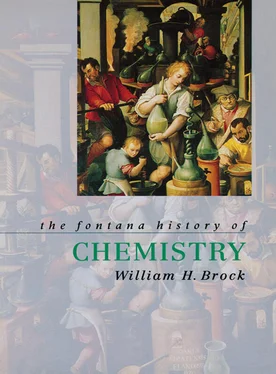After discussing the oxygen theory in part I of the Traité , he discussed their preparation and properties, their oxides and then their salts formed from acidic and basic oxides in part II. Caloric disengaged from oxygen explained the heat and light of combustion. It has been said that the elements formed the bricks while his new views on calcination and combustion formed the blueprint. The Traité itself formed a dualistic compositional edifice. Whenever an acidic earth and metal oxide (or earth) combined, they produced a salt, the oxygen they shared constituting a bond of union between them. As was appropriate for an elementary text, part III, a good third of the book, was devoted to chemical instrumentation and to the art of practical chemistry.
Lavoisier’s table of elements did not include the alkalis, soda and potash, even though these had not been decomposed. Why were they excluded from his pragmatic definition of simple substances? Two reasons have been suggested. In the first place, he was prepared to violate his criterion because of the chemical analogy between these two alkalis and ‘ammonia’, which Berthollet had decomposed into azote (nitrogen) and hydrogen in 1785. Lavoisier was so confident that soda and potash would be similarly decomposed into nitrogen and other unknown principles, that he withheld them from the table of simple substances. On the other hand, although confident that muriatic acid was also compound, because the evidence was not so strong as for the alkalis, he included it in the list of elements. While we may admire Lavoisier’s prescience – Davy was to decompose soda and potash in 1808 – this was a disturbing violation of his own pragmatism. What guarantee did the chemist have that any of Lavoisier’s simple substances were really simple? As we shall see, Lavoisier’s operational approach caused a century of uncertainty and helped to revive the fortunes of the ancient idea of primary matter.
A second explanation is more subtle. Lavoisier’s simple substances were arranged into four groups (see table 3.2). Three of the groups contained the six non-metals and seventeen metals then known, both of which were readily oxidizable and acidifiable, together with the group of five simple ‘earths’. The remaining group was light, caloric, oxygen, azote (nitrogen) and hydrogen. At first glance these elements appear to have nothing in common, but the heading Lavoisier gave them, ‘simple substances belonging to all the kingdoms of nature, which may be considered the elements of bodies’, provides the clue. Lavoisier probably saw these five elements as ‘principles’ that conveyed fundamental generic properties. Light was evidently a fundamental principle of vegetable chemistry; caloric was a principle of heat and expansibility; oxygen was the principle of acidity; hydrogen was the principle of water that played a fundamental role in all three kingdoms of Nature; and nitrogen was a principle of alkalinity. If the 1789 list of elements is compared with a preliminary list he published in 1787, it is found that azote was moved from its original position among the non-metals. It is not unlikely that this change was connected with the decomposition of ammonia and Lavoisier’s decision that soda and potash were compounds of ‘alcaligne’, a nitrogenous principle of alkalinity.
If this interpretation is correct, it illustrates again the role of continuity in Lavoisier’s revolutionary chemistry. Although we cannot now know if this was the position Lavoisier held – a position that was in any case subject to refutation and modification within a few years – it is intriguing to notice that organic chemists (beginning with Liebig) came to see certain elements, namely hydrogen, oxygen, carbon and nitrogen, as the ‘universal’ or ‘typical’ elements of mineral, animal and vegetable chemistry. It was on the basis of this that Gerhardt and Hofmann were to build a ‘type theory’ or organic classification and from which Mendeleev was to learn to classify a greatly extended list of elements in 1869.
By the mid 1790s the anti-phlogistonian camp had triumphed and only a few prominent chemists, such as Joseph Priestley, continued as significant critics. Unfortunately, by then the French Revolution had put paid to the possibility that Lavoisier would apply his insights to fresh fields of chemistry.
Although opposition to Lavoisier’s chemistry remained strong in Germany for a decade or more, largely for patriotic reasons, and although Cavendish and Priestley never converted, the speed of its uptake is impressive. Much depended, of course, on key teachers. In Germany, Sigismund Hermstadt (1760–1832) translated the Traité in 1792, and in the same year Christoph Girtanner (1760–1800) published a survey of Lavoisier’s chemistry. At Edinburgh the French-born Joseph Black, who had always taught that phlogiston was a principle of levity, lectured on the new chemistry while not necessarily committing himself to it until 1790. His successor, Thomas Charles Hope (1766–1844), ensured that large audiences of medical students learned the new theory after 1787. Scottish opposition seems to have been largely confined to geology, where James Hutton found phlogiston more accommodating to his theory that it was solar light and his need for a plutonic ignitor in the absence of oxygen deep inside the earth; and animal physiology, where, despite Lavoisier’s view of animal heat as the natural exothermic product of burning food inside the body, Adair Crawford developed a complex mechanism involving air, heat, blood, phlogiston and the specific heat capacity of blood.
Despite Lavoisier’s continued research after 1789 – for example, he began some promising work on the analysis of organic substances – he found his official activities as an academician and fermier taking up more and more of his time as the Revolution, which broke out in that year, created more and more technical and administrative problems.
When Lavoisier was born, France was still a monarchy and power lay firmly in the hands of the Crown and aristocracy together with the Roman Catholic church. These two powerful and sometimes corrupt groups, or Estates, which were virtually exempt from taxation, were the landlords of the majority Third Estate of peasant farmers, merchants, teachers and bankers from whom France’s wealth was derived. Agricultural depression, a rise in population and a succession of expensive wars (including France’s intervention in the American War of Independence in 1778) led France towards bankruptcy in the 1780s. The only solution to this seemed to be to introduce a more equitable system of taxation, which, in turn, involved the reformation of political structure, including the reduction of King Louis XVI’s despotic powers.
On 14 July 1789 revolution broke out with the storming of the Bastille prison in Paris. In fear of their lives, Crown and aristocracy renounced their privileges, while a National Assembly composed of the Third Estate drew up the Declaration of the Rights of Man. National unity was short-lived, however, as the more radical Jacobins manoeuvred for political power and the downfall of the monarchy. War with Austria and Prussia was to prove the excuse for the King’s execution on 21 January 1793. In the period of terror and anarchy that followed, Lavoisier was to lose his life. For, despite his undoubted support for the initial phase of the Revolution and his hard work within the Academy in improving the quality of gunpowder or in devising the metric system in 1790, his services to France and his international reputation were, in the words of one historian, ‘as dust in the balance when weighed against his profession as a Fermier-Géneral’. On 24 November 1793 Lavoisier and his fellow shareholders (including his father-in-law) were arrested and charged, ludicrously, with having mixed water and other ‘harmful’ ingredients in tobacco, charging excessive rates of interest and withholding money owed to the Treasury.
Читать дальше












